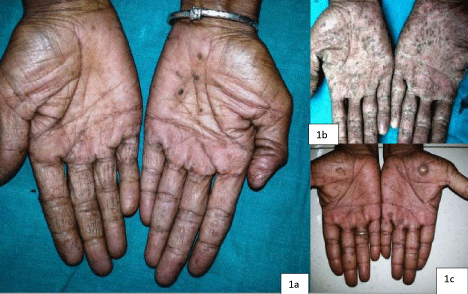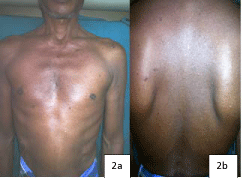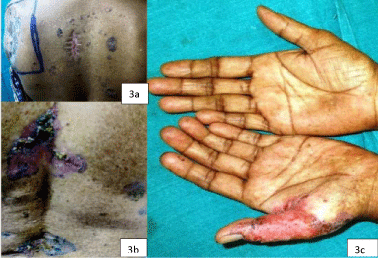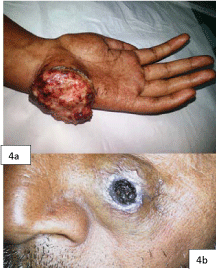Short Communication
Malignant Potential of Seemingly Naive Chronic Arsenicosis
Majumdar B1*, Mishra P2 and Chatterjee G2
1Department of Dermatology, Sawai Man Singh Hospital, India
2Department of Dermatology, Institute of post Graduate Medical Education and Research, India
*Corresponding author: Banashree Majumdar, Department of Dermatology, Sawai Man Singh Hospital, Jaipur, Rajasthan, India
Published: 26 Aug, 2016
Cite this article as: Majumdar B, Mishra P, Chatterjee G.
Malignant Potential of Seemingly Naive
Chronic Arsenicosis. Clin Oncol. 2016;
1: 1058.
Short Communication
World Health Organization working group defines Arsenicosis as a “chronic health condition
arising from prolonged ingestion (not less than 6 months) of arsenic above a safe dose, usually
manifested by characteristic skin lesions with or without involvement of internal organs”. WHO
Guideline value for acceptable level of arsenic in drinking water is 0.01 mg/L However WHO
acceptable level is associated with a significant life time risk of cutaneous malignancies of 6 in
10,000 [1,2]. Although arsenicosis is a global health problem, people living along the river Ganga in
India are the worst sufferer with lakhs of people being victims of chronic arsenicosis, many of them
ultimately developing malignancies. Industrialization and rampant use of insecticides, mining etc.
also contribute to this. Once inside the body, it exerts its toxicity by inactivating up to 200 enzymes,
many of them involved in cellular metabolism, DNA synthesis and repair. Excretion occurs via
urine although some remain in hair and nails.
Chronic arsenicosis affects many organs, however the burnt being on skin, with malignant
transformations, teratogenicity and genotoxicity [3-5].
Amongst all, the skin manifestations are the commonest and earliest to appear with hyperkeratosis
and pigmentary changes being the major manifestations. Both hyper and hypo pigmentation are
encountered, with the former commoner than the latter. Hyperpigmentation can be patchy or diffuse
favoring skin folds and trunk respectively. Spotted melanosis is also
referred to as rain drop pigmentation and hypo pigmented macules as
leucomelanos [6-8]. The pigmentary changes are due to stimulation
and subsequent destruction of melanocytes. In a minority of patients,
mucous membrane pigmentation could also be appreciated. Next in
sequence is keratosis of palms and soles which may be mild, moderate
and severe depending on the size of keratotic papules, less than 2mm,
2-5mm, and more than 5mm respectively. Furthermore, palmar
arsenical keratosis serves as an early marker of carcinogenicity
particularly of bladder and lung [9,10]. One more observation is, with
higher arsenic intake or longer duration (>10-15 yrs.), keratosis may
develop over dorsal surface of hands, feet, legs or even whole body.
Desquamative changes with exfoliative dermatitis like presentation
may also be seen. Malignancy in cases of chronic arsenicosis typically
does not usually develop before 10 years of exposure [8]. Skin, the
commonest site for arsenic induced malevolence develops Bowen’s
disease, basal cell carcinoma, squamous cell carcinoma with isolated
reports linking occasional occurrence of merkel cell carcinoma [11-
14]. An unique feature of arsenical malignancy is its propensity for
covered areas of body and its multiplicity. Keeping in mind the fact that
there is a definite increased risk of internal malignancies, individuals
with proven Bowen’s disease should be thoroughly screened for
visceral malignancies [15-18]. Additionally, a significant observation
is that chronic arsenic toxicity promotes cancer of the epithelial
tissue in human beings but not in rodents, further study revealed
that arsenic cause cancer in human beings through the activation
of an oncogenic virus like HPV which the rodents specifically lack
[19,20]. Discussion regarding malignancies in arsenicosis remain
incomplete without mentioning the fact that even though malignant
transformation progress slowly over years, nonetheless occasionally
in 6 months malignancy extends to neighboring glands and in 9
months to 1-year time, patient often dies.
Among non-cutaneous features anemia and leukopenia are
almost universal occurrence with frequent thrombocytopenia.
Others are respiratory distress, chronic cough, hepatomegaly, noncirrhotic
portal fibrosis, cirrhosis, ascites, peripheral vascular disease,
peripheral neuropathy, non-pitting edema, conjunctival congestion,
and hematuria.
Provision of arsenic free water and early detection of arsenicosis
can help people living in arsenic belt to be free of the disease in future.
Figure 1
Figure 2
Figure 2
a,b - Arsenical melanosis, rain drop pigmentation and leucomelanosis over anterior and posterior
trunk.
Figure 3
Figure 3
a,b - Premalignant lesions suggestive of Bowen’s disease over
posterior trunk.
c - Premalignant lesions suggestive of Bowen’s disease over palmar aspect
of thumb.
Figure 4
Figure 4
a - Cutaneous malignancy suggestive of squamous cell carcinoma
over thumb.
b - Cutaneous malignancy suggestive of nodulo-ulcerative variant of basal
cell carcinoma over cheek.
References
- Alistair C, Guy C, Jamie B, Sombo Y, Jacqueline S, Jose H, et al. “Towards an assessment of the socioeconomic impact of arsenic poisoning in Bangladesh”. WHO. 2000.
- Kapaj S, Peterson H, Liber K, Bhattacharya P. Human health effects from chronic arsenic poisoning: A review. J Environ Sci Health A Tox Hazard Subst Environ Eng. 2006; 41: 2399-2428.
- Tabacova S, Hunter ES III, Gladen BC. Developmental toxicity of inorganic arsenic in whole embryo culture: oxidation state, dose, time, and gestational age dependence. Toxicol Appl Pharmacol. 1996; 138: 298-307.
- Ramirez P, Eastmond DA, Laclette JP, Ostrosky-Wegman P. Disruption of microtubule assembly and spindle formation as a mechanism for the induction of aneuploid cells by sodium arsenite and vanadium pentoxide. Mutat Res. 1997; 386: 291-298.
- Mass MJ, Wang L. Arsenic alters cytosine methylation patterns of the promoter of the tumor suppressor gene p53 in human lung cells: a model for a mechanism of carcinogenesis. Mutat Res. 1997; 386: 263-277.
- Caussy D. A Field Guide for Detection, Management and Surveillance of Arsenicosis cases. New Delhi: World Health Organization, Regional Office of South-East Asia. 2005.
- Milton AH, Hasan Z, Rahman A, Rahman M. Non-cancer effects of chronic arsenicosis in Bangladesh: preliminary results. J Environ Sci Health A Tox Hazard Subst Environ Eng. 2003; 38: 301-305.
- Saha KC. Chronic arsenical dermatoses from tube-well water in West Bengal during 1983-87. Ind J Dermatol. 1995; 40: 1-12.
- Kadono T, Inaoka T, Murayama N, Ushijima K, Nagano M, Nakamura S, et al. Skin manifestations of arsenicosis in two villages in Bangladesh. Int J Dermatol. 2002; 41: 841-846.
- GuhaMazumder DN, Das Gupta J, Santra A, Pal A, Ghose A, Sarkar S, et al. Non-cancer effects of chronic arsenicosis with special reference to liver damage. In: CO Abernathy, RL Calderon, WR Chappell, editors. Arsenic: Exposure and Health Effects. London: Chapman and Hall. 1997; 112-123.
- Yoshida T, Yamauchi H, Fan Sun G. Chronic health effects in people exposed to arsenic via the drinking water: dose-response relationships in review. Toxicol Appl Pharmacol. 2004; 198: 243-252.
- Zaldivar R, Prunes L, Ghai G. Arsenic dose in patients with cutaneous carcinomata and hepatic hemangio-enothelioma after environmental and occupational exposure. Arch Toxicol. 1981; 47: 145-154.
- Yusra Ahmad BA. The Largest Mass Poisoning in Recorded History. International Health. 2004; 82: 57-58.
- Rosales-Castillo JA, Acosta-Saavedra LC, Torres R, Ochoa-Fierro J, Borja-Aburto VH, Lopez-Carrillo L, et al. Arsenic exposure and human papillomavirus response in non-melanoma skin cancer Mexican patients: a pilot study. Int Arch Occup Environ Health. 2004; 77: 418-423.
- Lien HC, Tsai TF, Lee YY, Hsiao CH. Merkel cell carcinoma and chronic arsenicism. J Am Acad Dermatol. 1999; 41: 641-643.
- Tsuruta D, Hamada T, Mochida K, Nakagawa K, Kobayashi H, Ishii M. Merkel cell carcinoma, Bowen′s disease and chronic occupational arsenic poisoning. Br J Dermatol. 1998; 139: 291-294.
- Ohnishi Y, Murakami S, Ohtsuka H, Miyauchi S, Shinmori H, Hashimoto K. Merkel cell carcinoma and multiple Bowen′s disease: incidental association or possible relationship to inorganic arsenic exposure? J Dermatol. 1997; 24: 310-316.
- Lee L, Bebb G. A case of Bowen′s disease and small-cell lung carcinoma: Long-term consequences of chronic arsenic exposure in Chinese traditional medicine. Environ Health Perspect. 2005; 113: 207-210.
- McDonnell JM, Mayr AJ, Martin WJ. DNA of human papilloma virus type 16 in dysplastic and malignant lesions of the conjunctive and cornea. N Engl J Med. 1989; 320: 1442-1446.
- Stohrer G. Arsenic: Opportunity for risk assessment. Arch Toxicol. 1991; 65: 525-531.




